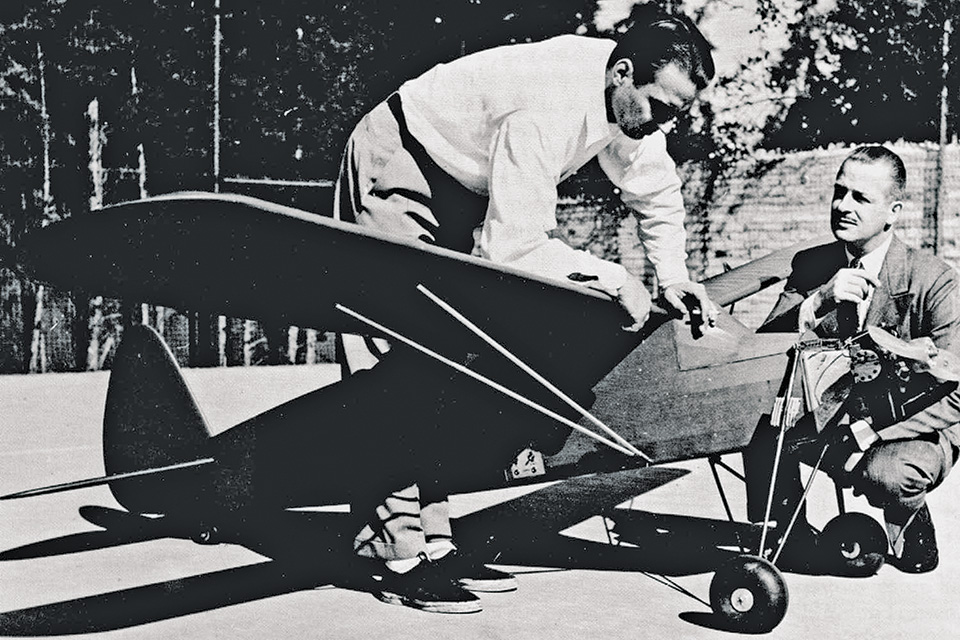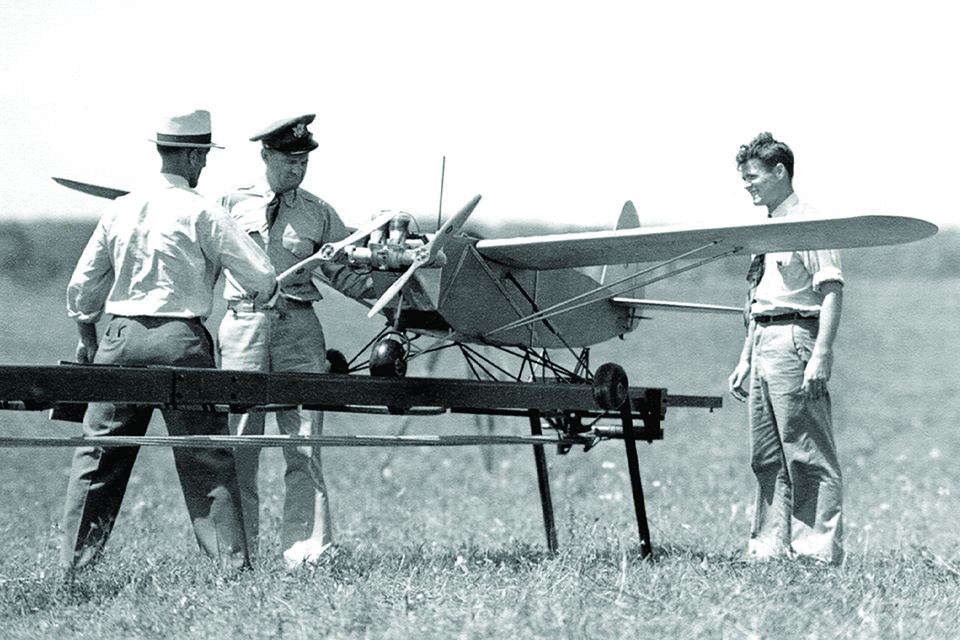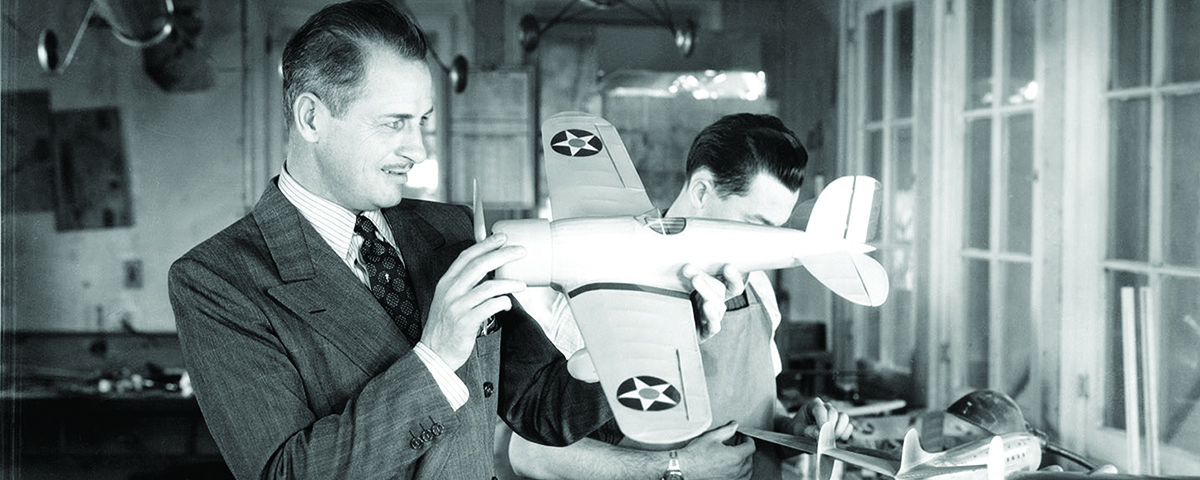Unmanned aircraft systems (UAS), better known as drones, have generated plenty of controversy in recent years. In addition to questions surrounding their employment in military strikes, the explosive growth of drones in hobbyist circles has forced the FAA to formulate rules governing their private use. Few are aware, however, that the first remotely piloted scaled aircraft date back to 1930s flying model hobbyists. And one of the most surprising and little-known aspects of the first military drones is their connection to Hollywood.
That Tinseltown connection was embodied by Reginald Denny, a well-known stage and screen actor who appeared in nearly 200 films in the course of a career spanning more than half a century. Born in Britain, he was the son of a stock company actor who performed in Gilbert and Sullivan’s operettas. Denny began acting professionally at age 6, and appeared in his first motion picture in 1912. He also became a British amateur boxing champion. Denny interrupted his career to join the Royal Flying Corps during World War I, serving as an observer/air gunner in Bristol F.2B Fighters with a home defense night fighter squadron. He was wounded, apparently by friendly anti-aircraft fire, during a nighttime interception training mission. He recovered sufficiently to complete his pilot training, but not in time to see any aerial combat before the war ended.
Denny resumed his acting career after WWI and starred in numerous Hollywood silent films, both dramas and comedies. Once the “talkies” arrived, however, his English accent and advancing age meant that he was more in demand for character parts, and he became a familiar face in a wide variety of supporting roles, usually as an impeccable English gentleman or military officer. Denny also continued to fly, joining an elite group of Hollywood stunt pilots known as the “Thirteen Black Cats.” That group included Art Goebel, winner of the tragic 1927 Dole Air Race from California to Hawaii, during which six of the eight airplanes that participated crashed, with the loss of 10 lives.

Denny’s interest in remote-control flying began one day in the early 1930s when he offered to assist a neighbor’s son who was trying to fly a model airplane. The plane crashed, and a contrite Denny insisted upon building a new one for the boy. That experience got the actor hooked on model airplane building to such an extent that in 1934 he opened a hobby shop, selling models of his own design. It quickly expanded into a business, Reginald Denny Industries, through which he marketed his line of Denny Plane flying models.
Denny also sold miniature gasoline engines for model planes. Designed and built by 1928 California Institute of Technology graduate Walter Righter, his Dennymite was the first truly reliable model airplane engine on the market. Denny selected the design after Righter demonstrated its reliability by constructing 10 prototypes and running them all flat-out for 50 hours. That demonstration marked the beginning of a fruitful association between the two men that would continue for many years.
During that period Denny also became acquainted with the work of fellow model airplane and radio enthusiast Kenneth Case, who had developed an efficient miniature radio-control system. Denny had the vision to realize the military potential of employing remotely controlled model airplanes as aerial targets. At a meeting on the subject that he arranged with Lt. Col. W.S. Thiel of the Coast Artillery, Denny learned it cost the U.S. Army $300 to tow an aerial target behind an airplane. Such targets were regarded as less than ideal for training because they had to be towed in a straight line, they didn’t resemble real airplanes and gunners often couldn’t tell if they had hit the target. Moreover, the towing aircraft and their crews could be struck by gunfire. Denny proposed that a remote-controlled model airplane would serve the purpose far more effectively, and he persuaded the Army to allow him to proceed with its development. In 1936 Denny and financier Paul Whittier established the Radioplane Company, with the goal of developing radio-controlled airplanes for use by the military as aerial targets.
Denny Industries’ first remote-controlled aerial target was the RP-1 (Radio Plane 1), a 42-pound high-wing monoplane with a 12-foot wingspan. It was powered by a 3-hp, 2-stroke, 2-cylinder engine built by Walter Righter. After Denny and Righter demonstrated the RP-1 to the Army in February 1938, the officials were sufficiently impressed with its potential to invite Denny to continue development. Radioplane built and demonstrated several more improved prototypes before the Army accepted the RP-4, 53 of which were ordered in May 1939 under the Army designation OQ-1 (reflecting its classification as a “subscale target”). The OQ-1 order represented the first of a total of 14,891 target drones of all types that Radioplane would produce during World War II.
In 1941 Radioplane’s RP-5 design, designated OQ-2 by the Army, succeeded the OQ-1 on the production line. It featured a number of improvements, including a new 2-cylinder horizontally opposed engine driving contrarotating propellers. The U.S. Navy also used it under the designation TDD-1 (for Target Drone, Denny).
Featuring steel-tube construction, the OQ-2 was 8 feet 8 inches long, had a wingspan of 12 feet 3 inches and weighed 104 pounds. Powered by a 7-hp Righter engine, it had a top speed of 85 mph and could remain airborne for an hour. The drone was launched from a catapult and, although equipped with a wheeled landing gear, was typically recovered by a parachute stowed inside the fuselage. While not as fast as a full-sized airplane, the diminutive drone seemed to be moving faster than it actually was, making it a difficult target to hit.

In 1943 the OQ-2 was superseded by the improved OQ-3, the most-produced variant, with 9,403 examples built. The OQ-3 was sturdier than the OQ-2 and had a more powerful 8-hp engine that increased its maximum speed to 102 mph. It was also simpler, dispensing with the contrarotating propellers and wheeled landing gear, and relying solely on the parachute for recovery.
Although Radioplane’s activities and products were considered highly classified, on one occasion in June 1945 an Army public relations photographer with the 1st Motion Picture Unit, Sergeant David Conover, visited the factory in Van Nuys, Calif., to document its operations. Conover was evidently less interested in what was being built in the plant than he was in a particularly attractive female worker there, Norma Jeane Dougherty. It may have been the first time Dougherty was noticed, but it would not be the last. Conover arranged a modeling audition for her that eventually led to a contract with the Blue Book Model Agency. She subsequently changed her hair color and name, entering the postwar film industry as Marilyn Monroe.
After WWII, Radioplane was involved in modifying four Grumman F6F Hellcat fighters as radio-controlled drones to fly reconnaissance missions through the nuclear blast zone at Bikini Atoll during Operation Crossroads in 1946. The four Hellcats were flown from USS Shangri-La, and Denny was on board the aircraft carrier at Bikini to assist in setting up the drones and ensuring they worked correctly.
Denny sold his interest in Radioplane in 1948, after postwar demand for radio-controlled targets began to diminish. He continued to play character roles on the large and small screen. His last film was the Frank Sinatra crime caper Assault on a Queen in 1966, and his last television appearances were in the campy Batman series that same year. He died of a stroke while visiting his native England, but he was buried near his adopted home, at Forest Lawn–Los Angeles Hills Cemetery.
The company Reginald Denny had founded continued to produce improved versions of its target drones, the most successful of which was the MQM-36 Shelduck, with 60,000 built during a decades-long production run. When Northrop bought the company in 1952, it became the Radioplane Division. Later the name was changed to the Ventura Division, Northrop Corporation.
Robert Guttman writes frequently for Aviation History Magazine from Tappan, N.Y. For more on Reginald Denny and Radioplane, see ctie.monash.edu.au/hargrave/denny.html.
Drones: The Hollywood Connection appeared in the November 2016 issue of Aviation History Magazine. Subscribe today!

